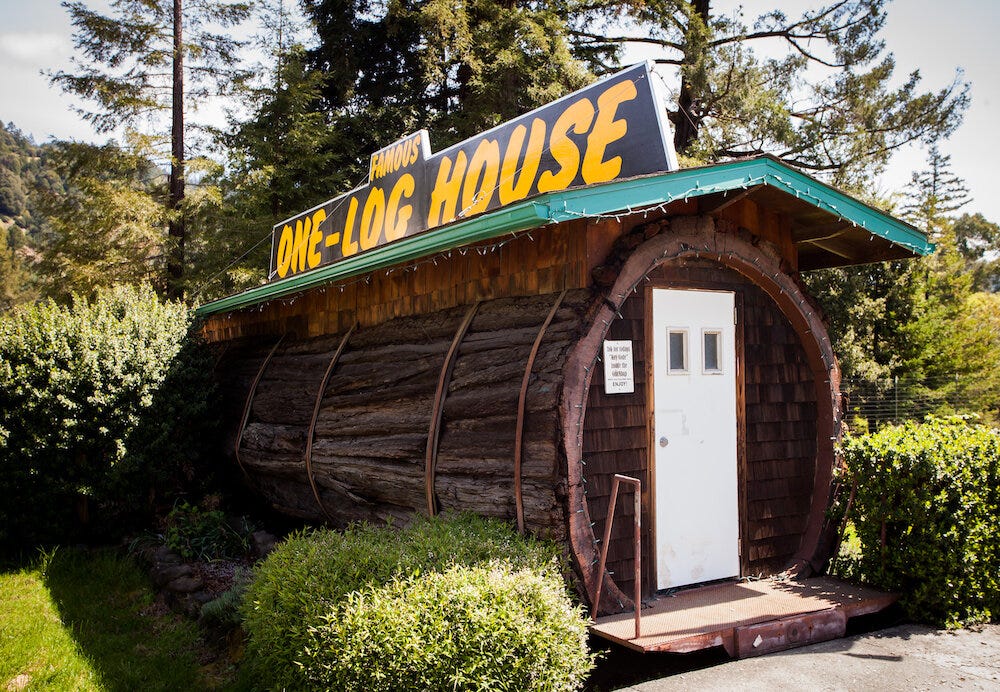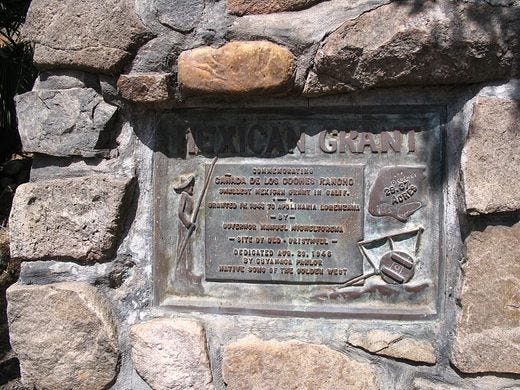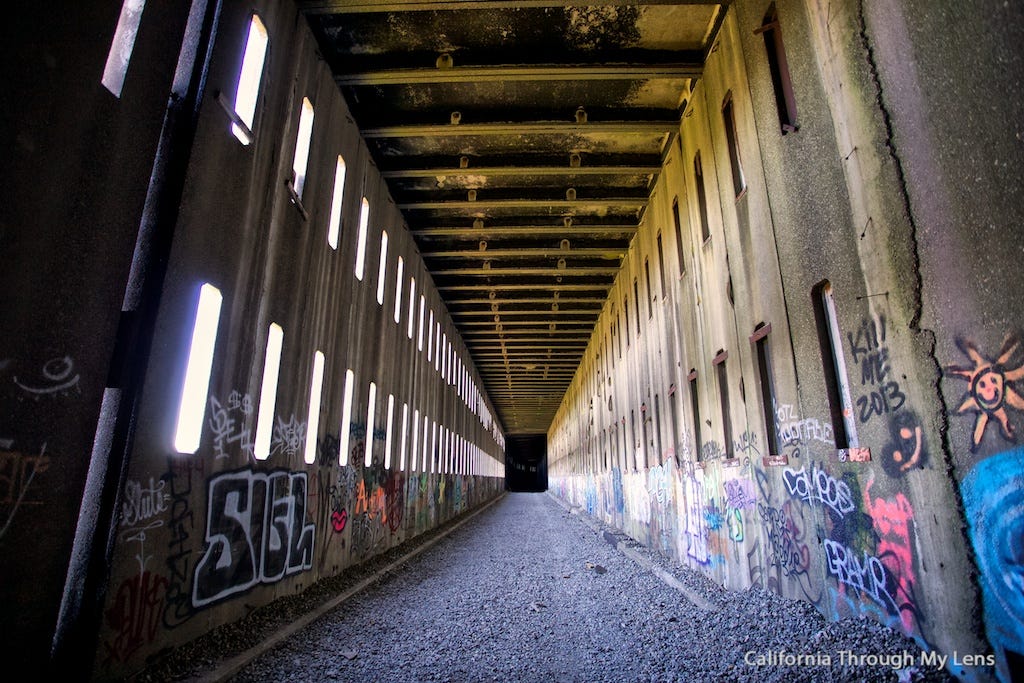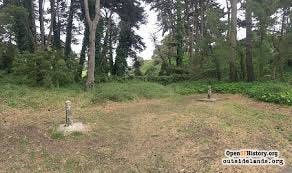Interesting Historical Places in California
A list and explanation of some interesting historical places in California
Let me start by saying that “interesting” is a subjective word, meaning that whether or not you think these places were interesting, it doesn’t matter, because I’m the writer and I do find them interesting. That sounds a bit rude, but to be fair, I’m a bit of a nerd, so what I find interesting might not apply to everyone, but if you’re reading this it’s likely because you opened a link or subscribed to my Substack, which means you ar least knew a little bit what you were getting into. All that nonsense being said, let’s dive in!
Dublin Gulch in Shoshone, California
Dublin Gulch is a ghost town that was founded in the late 1800s. It is mainly made of cave dwellings that were dug out by miners and railroad workers. The caves, dug out of compacted volcanic ash, helped to keep them cool in the summer and were well-insulated in the winter. Most only have one room, however some have multiple rooms with fireplaces and stovepipes, and one of them even has a garage.
The exact creation date isn’t known, but “1870” is carved near one dwelling. These dwellings were believed to have been lived in until the 1970s. It is rumored that some members of the Manson family lived in these caves once they were kicked out of Barker Ranch. Frank “Shorty” Harris, a well-known prospector in the area, also lived in the Gulch for a time.
The caves are easily accessible by car, they’re located just off highway 127 near Shoshone Cemetary, 1/4 mile up the dirt road. Some of the dwellings are open for exploration, some are locked or are only visible through windows. There are also fossilized footprints behind the Gulch where animals from the Ice Age used to drink from a watering hole.
There is also a Dublin Gulch in Butte, Montana.
One Log House in Piercy, California
The One Log House is a hollowed out, 2,100 year old redwood tree that was built in 1946. It took 8 months of hard labor from Art Schmock and a helper to hollow out the 42 ton section of the coastel redwood. It is 7 ft x 32 ft. It was first meant to be a travelling home. Schmock loaded the home onto a trailer to take it on a tour, however he had to abandon this idea because it was too heavy.
The home sat at Clam Beach for awhile, but was eventually moved to Cummings, where it stayed for 23 years. In 1999 it was moved to Richardson Grove State Park, it remains there and is still attached to its original trailer. There are no windows, and the cost to view it is only $1 per person. It is located at 705 Highway 101 in Piercy, California.
Colonel Allensworth State Historic Park in Earlimart, California
The park was originally established and governed only by black Americans who were seeking a place of their own to be free from discrimination. In 1908, Army veteran Colonel Allen Allensworth worked with other black intellectuals and leaders to found their own town. Afterward, black farmers, ranchers, craftsmen, and business owners from around the country moved to the town. It was intended to be the California equivalent of Tuskegee, Alabama, and was known as the “Tuskegee of the West” for a small portion of time.
After the death of Colonel Allensworth and increasing problems with the local water supply, the town began to decline. In 1974, the abandoned town was designated as a historical park, and only one of the buildings there is an original building from the settlement. The rest were demolished in 1966 due to levels of arsenic in the soil.
Reconstruction of the settlement is a constant effort, and there are frequent demonstrations by Buffalo Soldiers Re-enactors Association. The last man born in the settlement makes frequent visits to the park.
Rancho Canada de los Coches in Lakeside, California
This story has a bit of a tragic story. Located on a 28 acre site, it is the smallest land grant in California. It was granted to a teacher, nurse, and caretaker named Apolinaria Lorenzana, nicknamed “La Beata", (which means “the Blessed one,”) in 1843. It was given to her because of her work in the community.
Lorenzana was born in Mexico City, and came to what is now known as San Diego in 1800, with her mother. She was part of a Mexican government initiative to populate colonial settlements in what is now California. At the time, the government would send orphaned children, as well as children of young mothers, to live with settler families, or to be married off to local soldiers. Her mother married a soldier, and Apolinaria was moved to an orphanage. She was then placed with a family where she learned to read, write and perform skills like cooking, sewing and nursing. These skills lead her to start teaching, and because of this she headed a school, passing along her knowledge to the children of settlers and natives in the area. She was also active in the local mission and was put in charge of purchasing for the mission.
She received a land grant of nearly 9,000 acres for Santa Clara de Jamacha in 1840. She was then granted another piece of land known as Canada de los Coches in 1843. That land, however, was taken from her when the US invaded Mexico. A captain of the US Army told Lorenzana that the Army needed her land for their horses, and she asked for a payment for the land but never received it. The land was “purchased” by the Army captain and she would never be able to reclaim it.
Sadly, at the end of her life, Lorenzana was destitute, she had lost all of her land, which included the two land grants and a ranch that she had purchased. She lived in poverty in Santa Barbara until her death.
Donner Pass Summit Tunnels near Truckee, California
While this pass is more well-known for it’s graphic history due to the outcome of the migration of the Donner party, a man named Theodore Judah had a dream to build a railroad through the Central Pacific using the Sierra Nevada mountains. Only 21 years after the original Donner party passed through, the tunnels through the land that Judah surveyed would be finished. However, Judah passed away before he could see it finished. In the mid-1800s Judah surveyed a long stretch of the route that the Donner party used and found the money to make the transcontinental railroad a reality. Judah passed from Yellow Fever, which he contracted while passing through Panama on his way to New York City, in 1863. The tunnels were finished in 1867 and the first train went through in 1868.
The tunnels were constructed by Chinese laborers and took more than 15 months to finish, they were some of the most treacherous parts on the transcontinental railroad. The railroad linked Omaha, Nebraska to Oakland, California. The tunnels were finished using hand drilling, black powder, and nitroglycerine. These methods lead to anywhere from 500-1,000 deaths. Snow sheds were built between the tunnels, and they can still be seen from the interstate. In 1925, the railroad built a second route over Donner Pass, known as “Tunnel 41” or “The Big Hole.” It went directly through and under Mount Judah, which was named after the railroad pioneer.
This tunnel, which is 10,325 ft long, relieved congestion on the line. Both routes were used side by side until 1993, when the Union Pacific elected to cut costs by abandoning the original route in favor of Tunnel 41. The tunnel and snow sheds now sit abandoned, but are a popular place for hikers and snowshoers, although they are located on private property. Tunnel #6, which took tens of thousands of hours to finish. is the most famous of the tunnels. Tunnels #7 and #8, along with the “Chinese Wall” (built to hold up the trains as they transitioned between two tunnels) are the other parts of the system that are commonly visited. Ancient petroglyphs can also be seen nearby and are marked with a plaque. A full round trip hike of the tunnels is about 5 miles. Should you plan to make the trip, bring a flash light and sensible shoes for tunnel #6 as it can be wet and rocky.
Broderick-Terry Duel Site in Daly City, California
In a small park behind a golf course in Daly City, there are two pillars marked with the names “Broderick” and “Terry.” They are spaced at exactly 10 spaces apart, and they commemorate the spot where the last legally sanctioned duel on American soil was held. This duel happened on September 13th, 1859. It involved US Senator David C. Broderick of California and ex-Chief Justice of the Supreme Court of California David S. Terry. These two men were once friends and allies in politics, but they eventually came to odds on the subject of slavery, Terry being pro-slavery, and Broderick being against it. Terry challenged Broderick to a duel, police thwarted the first attempt to hold the duel, so the men rescheduled and decided to hold it in a more secluded spot. Terry seriously injured Broderick, who eventually succumbed to his injuries three days later.
Terry ended up having a bit of a tumultuous life. Later on he married Althea Hill, a woman who had previously been a mistress to silver millionaire and former US Senator William Sharon. She had been accused already of forging a marriage certificate to him. The relationship Terry had with Hill would eventually lead to his death. After Hill married Terry, she claimed to have found a will that former Senator Sharon had “left” to her. However, when it was brought to court, it was ruled that the will was also a forgery. The woman then yelled obscenities at Judge Stephen J. Field while fumbling for her revolver, but was removed from the courthouse by many, but including US Marshal John Franks before she was able to fire a shot. Terry, who was acting as her attorney, attacked Franks with a bowie knife and knocked out one of his teeth before being forcibly removed from the courthouse, threatening everyone around him the whole time, eventually surrendering when US Marshal David B. Neagle put a gun in his face. Once they were subdued, Terry was arrested and made to serve 6 months, and his new wife was made to serve 1 month. A year after this incident, Terry found himself on a train to San Francisco with the same Judge Field, and as they tried to deboard on a stop in Lathrop for breakfast, Terry attacked him but was shot by Neagle, who was also present in the court the day the will was ruled a forgery. This is when Terry died, thirty years after the duel with Broderick.
Neagle was charged with murder but was eventually released and the issue was resolved in In re Neagle, where the US Supreme Court determined that the US Attorney General had the authority to appoint US Marchals as bodyguards, and that in this case, Neagle was acting in defense for Judge Field.
After the original duel, Broderick was seen as a martyr for the anti-slavery movement. On June 1st, 1932, the markers were placed in Daly City and were registered as a California landmark. There is also a directional marker pointing visitors to the actual site of the ravine, where the duel took place, along with a plaque explaining the significance of the duel. On February 22, 1917, the Native Sons of the Golden West placed two granite shafts on the spots where the combatants stood. There is also a bronze plaque commemorating the duel. Some time since then, the plaque has gone missing, but in 1949 a California Historical Landmark plaque was dedicated in its place. Visitors are welcome to visit, and some people do their own duels using Nerf guns. It’s located in a small lot near a small group of private residences.
Truth be told, I still have seven other sites to write about, but seeing as how this article ended up being a lot longer than I originally planned, but I found the history so interesting I just couldn’t cut some of the research short! So I’m going to have to split this article up! Be on the lookout for a second article of cool places to visit, whether is be two weeks from now, or seven months from now. We’ll see.
Until then!
(Any underlined things in this article are links to my sources.)








